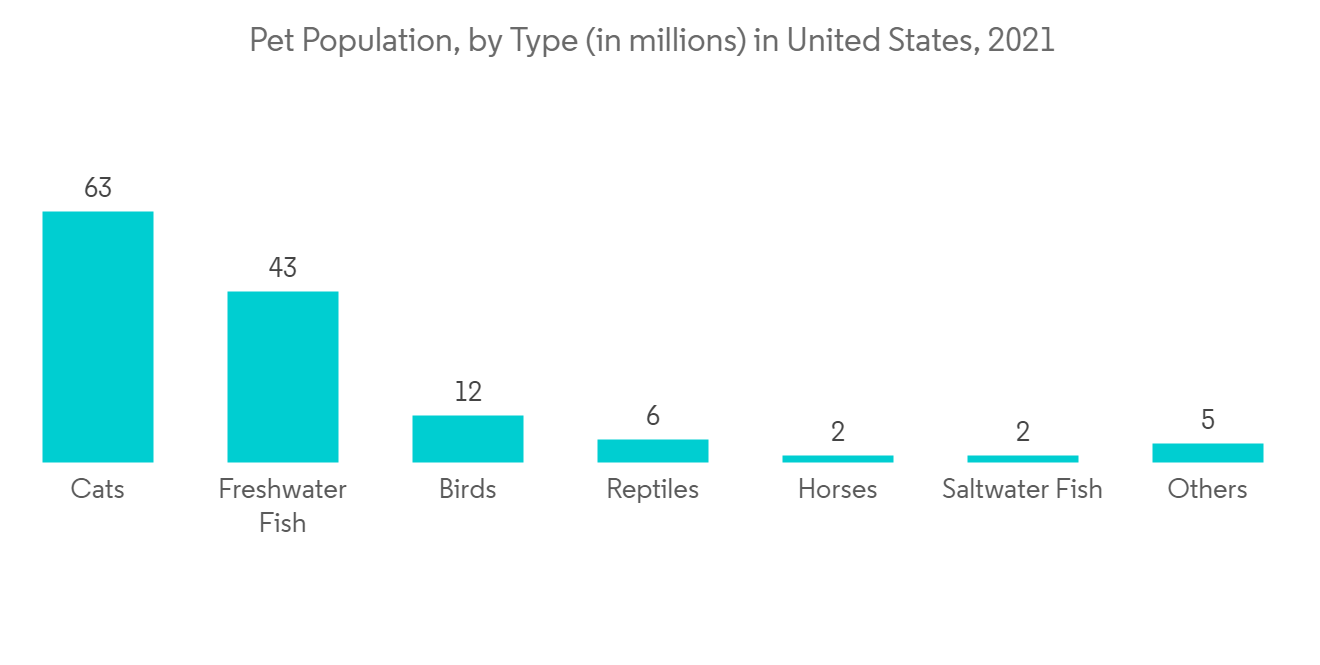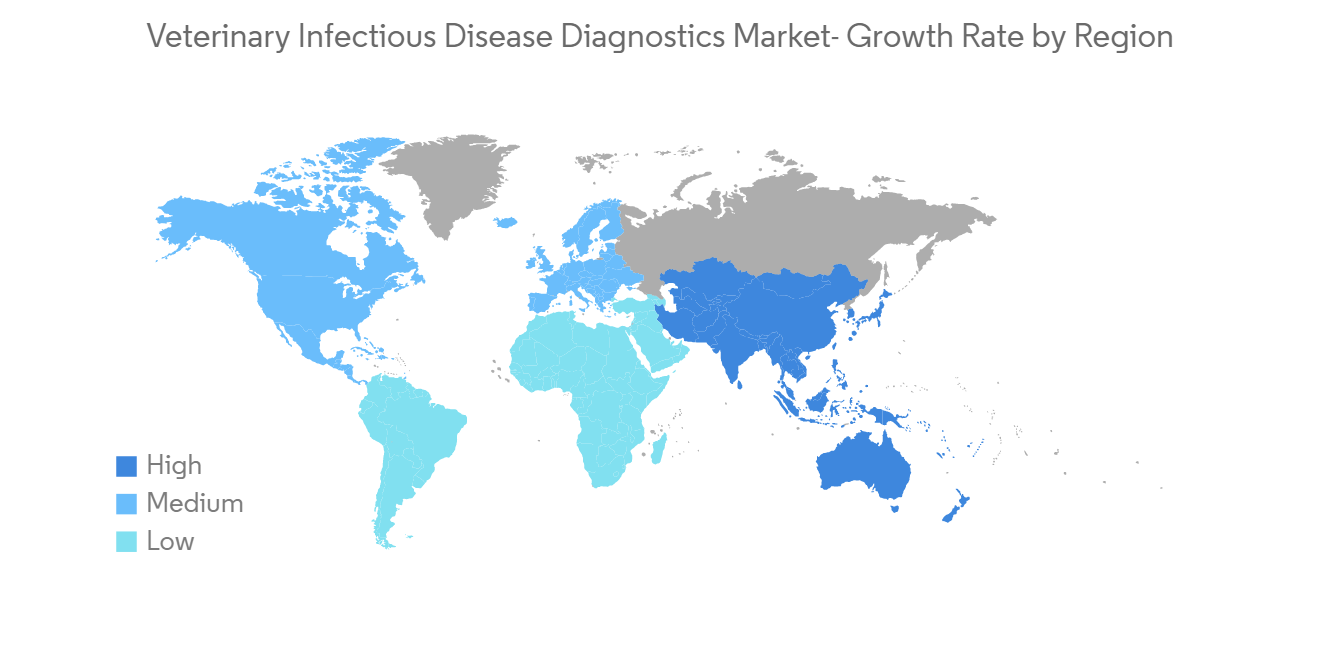PUBLISHER: Mordor Intelligence | PRODUCT CODE: 1273508

PUBLISHER: Mordor Intelligence | PRODUCT CODE: 1273508
Veterinary Infectious Disease Diagnostics Market - Growth, Trends, and Forecasts (2023 - 2028)
The Veterinary Infectious Disease Diagnostics Market is projected to register a CAGR of 7.5% during the forecast period.
During the COVID-19 pandemic, the veterinary infectious disease diagnostics market was moderately affected, as most countries and their states treat pet care/ animal care as an essential service. Therefore, the growth wasn't significantly declined during the pandemic. Since most countries treat veterinary practices as essential businesses, this allows the services to remain open even during pandemic-related restrictions and shutdowns. Still, some veterinary hospitals and clinics experienced a drop in pet care compliance in many key areas during the first few months of the pandemic. However, veterinary services resumed to some extent as the lockdown lifted. For instance, AmerisourceBergen Corporation 2020 reported that since December 2020, many veterinary services had shown signs of significant improvement. Moreover, the pandemic has seen a surge in pet adoption; for instance, according to the Insurance Research Council's October 2020 report, during the COVID-19 pandemic, nearly one in three (30 percent) of Americans adopted a pet. In March 2021, According to American Pet Products Association, around 67% of United States households own a pet, which is about 84.9 million homes. This increase in pet adoption is expected to increase the procurement and demand for veterinary infectious disease diagnoses soon.
Certain factors that are driving the market growth include increasing advanced diagnostic devices for animals, growing demand for pet insurance, and an increasing companion animal population. The North American Pet Health Insurance Association (NAPHIA) states that in 2020, pet health insurance for the United States showed gross written premiums of USD 1.99 billion. The market has been growing at an average annual growth rate of around 24.2% from 2016 to 2020. In December 2020, the total number of pets insured reached 3.4 million.
According to NAPHIA, around 20 pet insurance companies are in the North American region. With the increase in pet insurance, owners are more likely to take their pets for diagnostic testing. Similarly, the rise in zoonotic diseases is also one of the key reasons to increase diagnostic tests as it prevents diseases from spreading. According to the world wildlife fund research paper published in August 2020, 60.3% of all new emerging diseases are zoonoses.
Additionally, most infectious diseases originate in wildlife and are further spread to the companion animals and humans. This is one of the key issues in the Asia Pacific region, as most of the zoonotic diseases originate from the region. One of the notable examples is COVID-19. In Europe, many countries have favorable laws to support companion animals. The Commission Laws of the French National Assembly in 2014, the Czech Republic Civil Code of 2012, the United Kingdom Animal Welfare Act of 2006, the Austrian Constitution in 2004, the German Constitution in 2002, and Switzerland's Law of October 4, 2002, are a few notable examples. Due to these laws, there is a favorable approach to the diagnosis of animals, which incites a positive growth in the number of these animals. Hence, the increasing number of companion animals in households and farms will show positive growth for the market during the forecast period.
Therefore, owing to the aforementioned factors, the studied market is anticipated to witness growth over the analysis period. However, high pet care costs is likely to impede market growth.
Veterinary Infectious Disease Diagnostics Market Trends
The Immunodiagnostics segment is Expected to Witness Growth Over the Forecast Period
The dominance of this segment is mainly attributed to factors such as the increasing use of immunoassays in infectious disease testing, the development of novel tests, the rising trend of automation, increasing awareness about health and fitness, and reduce complications associated with the instruments.
For instance, in May 2021, as per the Manual of Clinical Microbiology, 11th Edition, immunoassays can be adapted for detecting analytes across laboratory disciplines and are often more cost-effective than other diagnostic methods. In the clinical microbiology laboratory, immunoassays often serve as confirmatory tests. Therefore, the results are typically not intended to be used as the sole basis for a diagnosis. However, for certain infectious diseases, including Lyme disease, cryptococcal meningitis, and syphilis, antibody and antigen detection by immunoassays is the primary means by which the infection is established. Due to their ease of use, rapid turnaround time, and generally high specificity, immunoassays are increasingly becoming available for point-of-care testing.
Earlier, the diagnostics for veterinary infectious diseases/pathogens have relied on methods for detecting the pathogen by antibodies or culture, using various techniques, such as Enzyme-linked Immunosorbent Assay (ELISA), neutralization, agar gel immunodiffusion, and complement fixation. However, in the past few years, improved immunoassay-based diagnostics tests have evolved and have replaced the more traditional methods, resulting in improved accuracy while requiring less time and effort. For instance, in April 2021, INDICAL, a global leader in developing complete solutions for molecular and immunological veterinary testing, acquired the Svanova product portfolio from Boehringer Ingelheim. This is enhanced by the production of specific proteins which serve as target antigen and makes it possible with new advanced biotechnological methods, such as the cloning of genes and the use of expression vectors. Due to these factors, the market will grow during the forecast period.
Furthermore, factors such as growing research collaborations, an increasing number of research laboratories, and growing direct and indirect investments in research and development (R&D) by pharmaceutical and biotechnology companies will increase product demand, fueling the market's growth in the coming years.

North America is Expected to Dominate the Hair Removal Devices Market
North America is expected to hold a major market share in the global veterinary infectious disease diagnostics market due to rising pet insurance, increased companion animals, and advanced diagnostic devices available in the region. According to the American Pet Products Association survey 2020-2021, around 65.2 million households own dogs, 43.3 million own cats, 5.8 million own birds, 5.3 million own small animals, and 1.8 million own horses, among others. This increasing number requires more diagnostic tests as zoonotic diseases can spread quickly due to more human and animal interactions. According to the American Pet Products Association survey 2020-2021, the basic annual expenses for dogs in an average United States household come to USD 429 for a Surgical vet and USD 213 for a routine visit. This puts the total United States pet industry expenditures around USD 82.31 billion in 2020-2021. The rise in expenditure shows a willingness in owners to go for diagnostic tests with their pets. Due to these factors, the market will show significant growth in the upcoming years.
Moreover, an increase in research and development activities and the presence of favorable healthcare infrastructure are fueling the growth of the overall regional market to a large extent. For instance, in September 2021, the International Society for Infectious Diseases (part of the United Nations) provides various grants in different fields of infectious diseases. Many of the grants are offered to veterinary infectious diagnostics. Similarly, the United States has a long-term agreement with Research Training Center for Animal Disease Diagnostics (Ukraine) which was signed on October 2010 to provide funding for clinical research (specifically for research, diagnostics, and training for animal health) in that region. Due to these factors, the market will see a growth period during the forecast period.

Veterinary Infectious Disease Diagnostics Industry Overview
The Veterinary Infectious Disease Diagnostics Market is moderately consolidated and competitive and consists of a few major players. In terms of market share, a few of the major players are currently dominating the market. Some companies currently dominating the market are Biomerieux S.A., Heska Corporation, IDEXX Laboratories, Inc., IDVet, Indical Bioscience, Neogen Corporation, Randox Laboratories, Ltd., Thermo Fisher Scientific Inc., Virbac and Zoetis, Inc.
Additional Benefits:
- The market estimate (ME) sheet in Excel format
- 3 months of analyst support
TABLE OF CONTENTS
1 INTRODUCTION
- 1.1 Study Assumptions
- 1.2 Scope of the Study
2 RESEARCH METHODOLOGY
3 EXECUTIVE SUMMARY
4 MARKET DYNAMICS
- 4.1 Market Overview
- 4.2 Market Drivers
- 4.2.1 Advanced Diagnostic Devices for Animals
- 4.2.2 Growing Demand for Pet Insurance
- 4.2.3 Increasing Companion Animal Population
- 4.3 Market Restraints
- 4.3.1 High Pet Care Costs
- 4.4 Porter's Five Force Analysis
- 4.4.1 Threat of New Entrants
- 4.4.2 Bargaining Power of Buyers/Consumers
- 4.4.3 Bargaining Power of Suppliers
- 4.4.4 Threat of Substitute Products
- 4.4.5 Intensity of Competitive Rivalry
5 MARKET SEGMENTATION
- 5.1 By Technology
- 5.1.1 Immunodiagnostics
- 5.1.2 Molecular Diagnostics
- 5.1.3 Others
- 5.2 By Animal Type
- 5.2.1 Companion Animals
- 5.2.2 Food Producing Animals
- 5.3 By Infection Type
- 5.3.1 Bacterial Infections
- 5.3.2 Viral Infections
- 5.3.3 Parasitic Infections
- 5.3.4 Others
- 5.4 By End User
- 5.4.1 Reference Laboratories
- 5.4.2 Veterinary Laboratories and Clinics
- 5.4.3 Point of Care/In House Testing
- 5.4.4 Others
- 5.5 Geography
- 5.5.1 North America
- 5.5.1.1 United States
- 5.5.1.2 Canada
- 5.5.1.3 Mexico
- 5.5.2 Europe
- 5.5.2.1 Germany
- 5.5.2.2 United Kingdom
- 5.5.2.3 France
- 5.5.2.4 Italy
- 5.5.2.5 Spain
- 5.5.2.6 Rest of Europe
- 5.5.3 Asia-Pacific
- 5.5.3.1 China
- 5.5.3.2 Japan
- 5.5.3.3 India
- 5.5.3.4 Australia
- 5.5.3.5 South Korea
- 5.5.3.6 Rest of Asia-Pacific
- 5.5.4 Middle East and Africa
- 5.5.4.1 GCC
- 5.5.4.2 South Africa
- 5.5.4.3 Rest of Middle East and Africa
- 5.5.5 South America
- 5.5.5.1 Brazil
- 5.5.5.2 Argentina
- 5.5.5.3 Rest of South America
- 5.5.1 North America
6 COMPETITIVE LANDSCAPE
- 6.1 Company Profiles
- 6.1.1 Biomerieux S.A.
- 6.1.2 Heska Corporation
- 6.1.3 IDEXX Laboratories, Inc.
- 6.1.4 IDVet
- 6.1.5 Indical Bioscience
- 6.1.6 Neogen Corporation
- 6.1.7 Randox Laboratories, Ltd.
- 6.1.8 Thermo Fisher Scientific Inc.
- 6.1.9 Virbac
- 6.1.10 Zoetis, Inc.
7 MARKET OPPORTUNITIES AND FUTURE TRENDS




